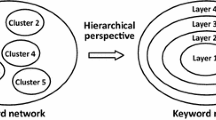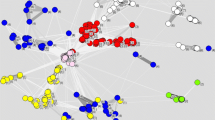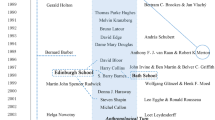Abstract
This study proposes a method to automatically establish a narrow-sense knowledge structure for Chinese Library and Information Science (CLIS) using data from the Chinese Social Science Citation Index. The method applies multi-level clustering, using ontological ideas as theoretical guidance and ontology learning techniques as technical means. Knowledge categories generated are checked for cohesion and coupling through hierarchical clustering analysis and multidimensional scaling analysis in order to verify the accuracy and rationality of the narrow-sense knowledge structure of CLIS. Finally, the narrow-sense knowledge structure is expanded to a broad sense. Using scholars as objects in examples, this study discusses the semantic associations between topic knowledge and the other academic objects in CLIS from the micro-, meso-, and macro-levels, so as to fully explore the broad-sense knowledge structure of CLIS for knowledge analysis and applications.

















Similar content being viewed by others
References
Aleixandre, J. L., Aleixandre-Tudo, J. L., Bolanos-Pizarro, M., et al. (2015). Mapping the scientific research in organic farming: A bibliometric review. Scientometrics, 105(1), 295–309.
Borgatti, S. P., Everett, M. G., & Freeman, L. C. (2002). Ucinet for windows: Software for social network analysis. Harvard, MA: Analytic Technologies.
Calabretta, G., Durisin, B., & Ogliengo, M. (2011). Uncovering the intellectual structure of research in business ethics: A journey through the history, the classics, and the pillars of Journal of Business Ethics. Journal of Business Ethics, 104(4), 499–524.
Chang, Y. W. (2012). Tracking scientometric research in Taiwan using bibliometric and content analysis. Journal of Library and Information Studies, 10(2), 1–20.
Charvet, F. F., Cooper, M. C., & Gardner, J. T. (2008). The intellectual structure of supply chain management: A bibliometric approach. Journal of Business Logistics, 29(1), 47–73.
Chen, C. M. (2006). CiteSpace II: Detecting and visualizing emerging trends and transient patterns in scientific literature. Journal of the American Society for Information Science and Technology, 57(3), 359–377.
Chen, L. C., & Lien, Y. H. (2011). Using author co-citation analysis to examine the intellectual structure of e-learning: A MIS perspective. Scientometrics, 89(3), 867–886.
Chen, C. M., & Paul, R. J. (2001). Visualizing a knowledge domain’s intellectual structure. Computer, 34(3), 65–71.
Cho, J. (2014). Intellectual structure of the institutional repository field: A co-word analysis. Journal of Information Science, 40(3), 386–397.
Danell, J. A. B. (2014). Reception of integrative and complementary medicine (ICM) in scientific journals: A citation and co-word analysis. Scientometrics, 98(2), 807–821.
Darvish, H., & Tonta, Y. (2016). Diffusion of nanotechnology knowledge in Turkey and its network structure. Scientometrics, 107(2), 569–592.
de Nooy, W., Mrvar, A., & Batagelj, V. (2005). Exploratory social network analysis with Pajek. UK: Cambridge University Press.
Dehdarirad, T., Villarroya, A., & Barrios, M. (2014). Research trends in gender differences in higher education and science: A co-word analysis. Scientometrics, 101(1), 273–290.
Erserim, A. (2016). Intellectual structure of accounting research: A historical review on the Journal of Accounting Organization Society. Accounting and Finance Research, 5(2), 1–9.
Ester, M., Kriegel, H. P., Sander, J., & Xu, X. (1996). A density-based algorithm for discovering clusters in large spatial databases with noise. In Proceedings of the 2nd ACM SIGKDD, Portland, Oregon (pp. 226–231).
Falconer, S. (2015). OntoGraf. http://protegewiki.stanford.edu/wiki/Onto-Graf. Accessed by 2015-07-01.
Galvagno, M. (2011). The intellectual structure of the anti-consumption and consumer resistance field: An author co-citation analysis. European Journal of Marketing, 45(11–12), 1688–1701.
Garcia-Lillo, F., Ubeda-Garcia, M., & Marco-Lajara, B. (2016). The intellectual structure of research in hospitality management: A literature review using bibliometric methods of the journal International Journal of Hospitality Management. International Journal of Hospitality Management, 52, 121–130.
Gonzalez-Alcaide, G., Castello-Cogollos, L., Navarro-Molina, C., et al. (2008). Library and information science research areas: Analysis of journal articles in LISA. Journal of the American Society for Information Science and Technology, 59(1), 150–154.
Hong, Y., Yao, Q., Yang, Y., et al. (2016). Knowledge structure and theme trends analysis on general practitioner research: A co-word perspective. BMC Family Practice, 17, 10.
Hooper, R. P. (2009). Towards an intellectual structure for hydrologic science. Hydrological Processes, 23(2), 353–355.
Hossain, M. G., Reza, A. H. M. S., Lutfun-Nessa, M., et al. (2013). Factor and cluster analysis of water quality data of the groundwater wells of Kushtia, Bangladesh: Implication for arsenic enrichment and mobilization. Journal of the Geological Society of India, 81(3), 377–384.
Hu, C. P., Hu, J. M., & Deng, S. (2013). A co-word analysis of library and information science in China. Scientometrics, 97(2), 369–382.
Hult, G. T. M. (2016). JAMS 2010–2015: Literature themes and intellectual structure. Journal of the Academy of Marketing Science, 43(6), 663–669.
Jeong, S., & Kim, H. G. (2010). Intellectual structure of biomedical informatics reflected in scholarly events. Scientometrics, 85(2), 541–551.
Kim, H., & Lee, J. Y. (2008). Exploring the emerging intellectual structure of archival studies using text mining: 2001–2004. Journal of Information Science, 34(3), 356–369.
Kumar, K. M., & Reddy, A. R. M. (2016). A fast DBSCAN clustering algorithm by accelerating neighbor searching using groups method. Pattern Recognition, 58, 39–48.
Kurihara, T., Tomari, N., & Aratani, T. (2013). Trend of EASTS research in the past 20 years. In Proceedings of the eastern Asia society for transportation studies (Vol. 9).
Leydesdorff, L., & Vaughan, L. (2006). Co-occurrence matrices and their applications in information science: Extending ACA to the Web environment. Journal of the American Society for Information Science and Technology, 57(12), 1616–1628.
Liu, Z. (2005). Visualizing the intellectual structure in urban studies: A journal co-citation analysis (1992–2002). Scientometrics, 62(3), 385–402.
Ma, R. M. (2012). Discovering and analyzing the intellectual structure and its evolution of LIS in China, 1998–2007. Scientometrics, 93(3), 645–659.
Ma, R., & Ni, C. (2011). The intellectual structure and its evolution of LIS in China based on the co-citation analysis. Journal of Library Science in China, 6, 17–26.
Machado, R. D., Vargas-Quesada, B., & Leta, J. (2016). Intellectual structure in stem cell research: Exploring Brazilian scientific articles from 2001 to 2010. Scientometrics, 106(2), 525–537.
McCain, K. W. (1990). Mapping authors in intellectual space: A technical overview. Journal of the American Society for Information Science, 41(6), 433–443.
Meyer, M., Zaggl, M. A., & Carley, K. M. (2011). Measuring CMOT’s intellectual structure and its development. Computational and Mathematical Organization Theory, 17(1), 1–34.
Milojevic, S., Sugimoto, C. R., Yang, E. J., et al. (2011). The cognitive structure of library and information science: Analysis of article title words. Journal of the American Society for Information Science and Technology, 62(10), 1933–1953.
Naghizadeh, R., Elahi, S., Manteghi, M., et al. (2015). Through the magnifying glass: An analysis of regional innovation models based on co-word and meta-synthesis methods. Quality & Quantity, 49(6), 2481–2505.
Nerur, S. P., Rasheed, A. A., & Natarajan, V. (2008). The intellectual structure of the strategic management field: An author co-citation analysis. Strategic Management Journal, 29(3), 319–336.
Olijnyk, N. V. (2015). A quantitative examination of the intellectual profile and evolution of information security from 1965 to 2015. Scientometrics, 105(2), 883–904.
Otte, E., & Rousseau, R. (2002). Social network analysis: A powerful strategy, also for theinformation sciences. Journal of Information Science, 28(6), 441–453.
Park, H. W., & Leydesdorff, L. (2008). Korean journals in the Science Citation Index: What do they reveal about the intellectual structure of S & T in Korea? Scientometrics, 75(3), 439–462.
Persson, O., Danell, R., & Wiborg Schneider, J. (2009). How to use Bibexcel for various types of bibliometric analysis. In Åström, F., Danell, R., Larsen, B., & Schneider, J. (Eds.), International society for scientometrics and informetrics, Leuven, Belgium (pp. 9–24).
Pilkington, A., & Meredith, J. (2009). The evolution of the intellectual structure of operations management-1980–2006: A citation/co-citation analysis. Journal of Operations Management, 27(3), 185–202.
Pinto, M. (2015). Viewing and exploring the subject area of information literacy assessment in higher education (2000–2011). Scientometrics, 102(1), 227–245.
Powers, J. H. (1995). On the intellectual structure of the human-communication discipline. Communication Education, 44(3), 191–222.
Pratt, J. A., Hauser, K., & Sugimoto, C. R. (2012). Defining the intellectual structure of information systems and related college of business disciplines: A bibliometric analysis. Scientometrics, 93(2), 279–304.
Prebor, G. (2010). Analysis of the interdisciplinary nature of library and information science. Journal of Librarianship and Information Science, 42(4), 256–267.
Protégé. http://Protege.stanford.edu. Accessed by July 1st, 2015.
Ravikumar, S., Agrahari, A., & Singh, S. N. (2015). Mapping the intellectual structure of scientometrics: A co-word analysis of the Journal Scientometrics (2005–2010). Scientometrics, 102(1), 929–955.
Riviera, E. (2015). Testing the strength of the normative approach in citation theory through relational bibliometrics: The case of Italian sociology. Journal of the Association for Information Science and Technology, 66(6), 1178–1188.
Rusk, R. D., & Waters, L. (2015). A psycho-social system approach to well-being: Empirically deriving the five domains of positive functioning. Journal of Positive Psychology, 10(2), 141–152.
Samiee, S., & Chabowski, B. R. (2012). Knowledge structure in international marketing: A multi-method bibliometric analysis. Journal of the Academy of Marketing Science, 40(2), 364–386.
Sarafis, I. A., Trinder, P. W., & Zalzala, A. M. S. (2007). Nocea: A rule-based evolutionary algorithm for efficient and effective clustering of massive high-dimensional databases. Applied Soft Computing, 7(3), 668–710.
SAS. http://www.sas.com/en_us/home.html. Accessed by July 1st, 2015.
Seyedghorban, Z., Matanda, M. J., & LaPlaca, P. (2016). Advancing theory and knowledge in the business-to-business branding literature. Journal of Business Research, 69(8), 2664–2677.
Sluyter, A., Augustine, A. D., Bitton, M. C., et al. (2006). The recent intellectual structure of geography. Geographical Review, 96(4), 594–608.
Song, M., & Kim, S. Y. (2013). Detecting the knowledge structure of bioinformatics by mining full-text collections. Scientometrics, 96(1), 183–201.
SPSS. http://www-01.ibm.com/software/analytics/spss/. Accessed by July 1st, 2015.
Su, X. (2007). Report on the academic influence of research achievement in China’s humanities and social sciences. Beijing: China Social Sciences Publishing House.
Su, X., & Zou, Z. (2011). Report on the academic influence of research achievement in China’s humanities and social sciences (2011). Beijing: Higher Education Press.
Torres-Salinas, D., & Moed, H. F. (2009). Library catalog analysis as a tool in studies of social sciences and humanities: An exploratory study of published book titles in Economics. Journal of Informetrics, 3(1), 9–26.
Triventi, M. (2014). Higher education regimes: An empirical classification of higher education systems and its relationship with student accessibility. Quality & Quantity, 48(3), 1685–1703.
Tseng, Y. H., & Tsay, M. Y. (2013). Journal clustering of library and information science for subfield delineation using the bibliometric analysis toolkit: CATAR. Scientometrics, 95(2), 503–528.
Van Eck, N. J., & Waltman, L. (2010). Software survey: VOSviewer, a computer program for bibliometric mapping. Scientometrics, 84(2), 523–538.
Wang, H. (2010). Information resource network model and its application. Nanjing: Nanjing University Press.
Wang, C. H., Lee, Y. D., Chou, H. L., & Kuo, J. H. (2014). Identifying the intellectual structure of risk management studies. In Proceedings of IEEE workshop on electronics, computer and applications (IWECA), Ottawa, Canada (pp. 964–968).
White, H. D., & McCain, K. W. (1998). Visualizing a discipline: An author co-citation analysis of information science, 1972–1995. Journal of The American Society for Information Science, 49(4), 327–355.
Wolfram, D., & Zhao, Y. H. (2014). A comparison of journal similarity across six disciplines using citing discipline analysis. Journal of Informetrics, 8(4), 840–853.
Yan, B. N., Lee, T. S., & Lee, T. P. (2015). Mapping the intellectual structure of the internet of things (IoT) field (2000–2014): A co-word analysis. Scientometrics, 105(2), 1285–1300.
Yang, S. L., Han, R. Z., Wolfram, D., et al. (2016). Visualizing the intellectual structure of information science (2006–2015): Introducing author keyword coupling analysis. Journal of Informetrics, 10(1), 132–150.
Yoo, Y. J., Lee, J. Y., & Choi, S. (2013). Intellectual structure of Korean theology 2000–2008: Presbyterian theological journals. Journal of Information Science, 39(3), 307–318.
Zhang, T., Ramakrishnan, R., & Livny, M. (1996). BIRCH: An efficient data clustering method for very large databases. In Proceedings of the ACM SIGMOD international conference on management of data (Vol. 25, pp. 103–114).
Zong, Q. J., Shen, H. Z., Yuan, Q. J., et al. (2013). Doctoral dissertations of Library and Information Science in China: A co-word analysis. Scientometrics, 94(2), 781–799.
Acknowledgments
This work was supported by Jiangsu Province’s Natural Science Foundation Project named “Study on Chinese Ontology Learning-Oriented Patent Forewarning” (No. BK20130587), as well as a major program of the National Social Science Foundation of China named “Studies on Deep Polymerization and Services of Network Information Resource-Oriented Discipline Field” (No. 12&ZD221).
Author information
Authors and Affiliations
Corresponding author
Rights and permissions
About this article
Cite this article
Wang, H., Deng, S. & Su, X. A study on construction and analysis of discipline knowledge structure of Chinese LIS based on CSSCI. Scientometrics 109, 1725–1759 (2016). https://doi.org/10.1007/s11192-016-2146-4
Received:
Published:
Issue Date:
DOI: https://doi.org/10.1007/s11192-016-2146-4




